-
SHIN ULTRAMAN シン・ウルトラマン (Shinji Higuchi, Japan 2022)
SHINJI HIGUCHI: SHIN ULTRAMAN シン・ウルトラマン(JAPAN 2022)
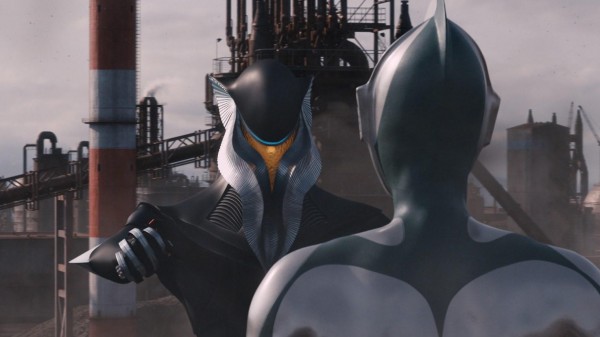
THE IMAGES OF SHIN ULTRAMAN ARE GLORIOUSLY ARTIFICIAL
"Irony" des-ne?
Matt Schley reviews the new Shin Ultraman in The Japan Times. He explains Shin Ultraman is a "gentle silver giant" who invaded Japanese TV screens 56 years ago to slay monsters and delight children. This movie is first of all a deliberately campy re-evocation of that popular favorite. It starts with a shiny new reimagining of the most successful tokusatsu-vs.-kaiju series of all time, with the silver superhero helping earthlings fight off monsters from space. There are some nice new ideas.
Creative duo Hideaki Anno (Evangelion) and Shinji Higuchi (Attack on Titan). These two titans of otaku cinema and avowed fans of "crashy, stompy" Japanese classics in 2016 already created a revival of the Godzilla franchise. This time they have teamed up to revive another creation from the late special-effects legend Eiji Tsuburaya.
Half this movie consists of fun recreations of the old effects of giants and monsters roaming the earth and terrifying earthlings such as nicely dressed and nice looking young bureaucrats assigned to figure them out and launch opposition to them and largely filmed separately.
But sometimes there's a thought-provoking twist, such as "SELF DEFENSE AGAINST TERRESTRIALS THROUGH HUMAN GIANTFICATION." One of the office team, ASami, comes back as a giant replication of herself that is alive, but absolutely impenetrable, and therefore a powerful weapon. And no radioactivity or chemical damage.
Thereupon, Extraterrestrial #0 arrives in human (well-dressed Japanese male) form, bowing and politely presenting a calling card just like a Japanese businessman. "When in Rome do as the Romans do," he intones; he likes to spout human clichés like this. First of all to establish his bona fides he must display some dramatic special effects to demonstrate to the onlookers that he is, despite appearances, really an extraterrestrial. It seems like he may be an alien arms salesman.
The giant version of Asami, it's announced, is like a mixture of Gulliver's Travels and (since giant Asami falls down into a trance) Sleeping Beauty. The scenes of her (simply combining images of two different sizes) really do remind one of illustrations for Gulliver, and the idea of recreating Jonathan Swift's masterpiece in an ironic homage to Fifties sci-fi is very interesting. And there is always the nice irony of recreating crude early sci-fi movie effects using sophisticated 21st-century CGI.
The attraction of the old effects is still there; it's just a question of finding some way of approaching them. As Phil Tippett's recently-issued Mad God illustrates, there is still something rich and special about DIY techniques like painstakingly handmade as stop-motion animation.
One would assume the best discussions of this film, its predecessors and its successors would be Japanese, but there is a good Italian blog Sonatine: Appunti sul cinema giapponese in which Matteo Boscarol provides a wealth of information about the context. We might also consider that a country with Japan's history of xenophobia might have a continuing affinity for the paranoia reflected in Fifties foreign invasion sci-fi movies.
Extraterrestrial #0 deems Ultraman's earthly aims to be unacceptable, so he assumes similar form and there is a knock-down battle between them to round out the film in spectacular fashion, but it's the dialogue of the well dressed young bureaucrats that makes all the film's points.
Shin Ultraman シン・ウルトラマン, 112 mins., opened in Indonesia and Japan May 13, 2022, and also showed at festivals including Neufchatel and Montreal. It was screened for this review as part of the Jul. 15-31, 2022 New York Asian Film Festival. U.S. Premiere.
Saturday Jul 23, 1:00pm (Walter Reade Theater, Film at Lincoln Center)
Director Shinji Higuchi and Producer Tomoya Nishino will attend the screening.
Last edited by Chris Knipp; 07-11-2022 at 12:52 PM.
-
FINDING BLISS: FIRE AND ICE - THE DIRECTOR'S CUT (Kim Chan, Dee Lam 2022)
KIM CHAN, DEE LAM: FINDING BLISS: FIRE AND ICE - THE DIRECTOR'S CUT 尋找極致的喜悅:火與冰 (HONG KONG, 2022)
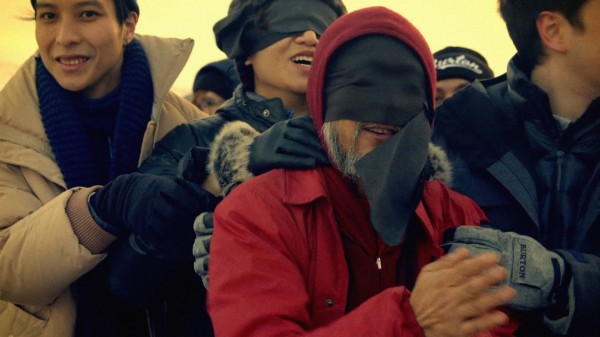
Meet Josie Ho, Jim Chim, MC Yan and a bunch of other men and women from Hong Kong, thespians, musicians, and students, who go on a trip for a few days to Iceland to open up and experience things.
TRAILER
In Ron Shelton's Hollywood Homicide (2003), Josh Hartnett plays a good natured doofus of a young cop whose hobby is "finding my "bliss." That is what this group of talented but tense Hongkongers is explicitly doing under the leadership of Josie Ho on their trip to Iceland, where they do workshops to develop physical and emotional trust, a sense of fun, and an ability to feel themselves around wearing blindfolds. It all ends with a big jam session with ten or a dozen Icelandic musicians where they perform a spontaneous version of an Icelandic song with multiple instruments and voices. Along the way there are visits to, and views of, some spectacular and elemental Icelandic landscapes. The contrast with the tiny overpriced flats, crowded streets, and tall buildings of Hong Kong couldn't be greater.
Early on people explain what sadly we know: that in the 25 years since the mainland Chinese takeover of Hong Kong people have become more and more unhappy. Maintaining autonomy has proven to be an impossible dream. Many have left, and still are leaving. Some just can't. Everybody is depressed. Hong Kong was recently listed as the Interestingly, on the trip somebody reports that a couple of decades ago there were a lot of suicides in Iceland. But government authorities took the matter in hand and by establishing a great number of music academies, far out of proportion to the size of the little country, the general mood has been turned around and now Iceland is one of the happiest countries, whereas Hong Kong is low down on the scale. (Of course these things are subjective and change every year.)
Part of the group traveling to Iceland and prominent in the film are Josie Ho and her indie rock group Josie and the Uni Boys, together with Cheung Yee-sik (drummer and sound technician), MC Yan (rapper and street artist), Jimmy Mak (guitarist and BMX cycler), Jan Lo (singer), along with group leader Jim Chim, a theatre actor and comedian. Chim helps the group find a kind of bliss within themselves, via a workshop inspired by the philosophy of Philippe Gaulier, a master clown and theatre performance teacher.
It isn't easy to make a series of exercises interesting. What is going on is clearly more fun to the participants than it is for the viewers of thjs documentary. But we realize something has been going right when we see the Hongkongers, including the shyest of them, joyously busking in the streets of Reykjavik, and then the big successful, galvanizing, joyous jam session at the end, led by Icelandic singers and musicians and Hong Kong ones, including the bearded, Zen MC Yan, said to be the no. 1 rapper of Hong Kong.
One person says "We have been in Iceland for five days and we have learned nothing." But most of the participants appear to be loosening up and having fun right from the beginning. And if the exercises enthusiastically led by Mr. Chim can pall after a while, the final jam session is really fun and reminded me of the way the infectiously blissful young British musical genius Jacob Collier can galvanize an audience and fill them with improvised musical joy.
For this review I have drown on the review from Udine by Greta Elettra Broms published on easternkicks.com.
Finding Bliss: Fire and Ice - The Director's Cut, 80 mins., released Hong Kong 2022. North American premiere. Screened here for review as part of the Jul. 15-31, 2022 New York Asian Film Festival.
Monday Jul 18, 8:30pm (Walter Reade Theater, Film at Lincoln Center)
Director Kim Chan and Actor Josie Ho will attend the screening.

JIM CHIM (BIG GLASSES) LEADS WORKSHIP IN FINDING BLISS
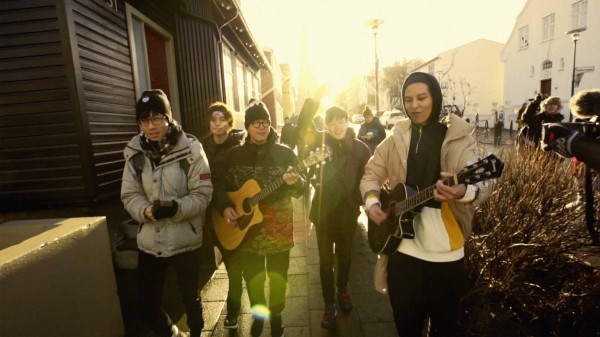
THE HONG KONG GROUP ENJOY BUSKING IN ICELAND IN FINDING BLISS
Last edited by Chris Knipp; 07-11-2022 at 12:54 PM.
-
LEGENDARY IN ACTION! 大俠Action! (Justin Cheung, Li Ho, Hong Kong, 2022)
JUSTIN CHEUNG, LI HO: LEGENDARY IN ACTION! 大俠Action!(Hong Kong 2022)
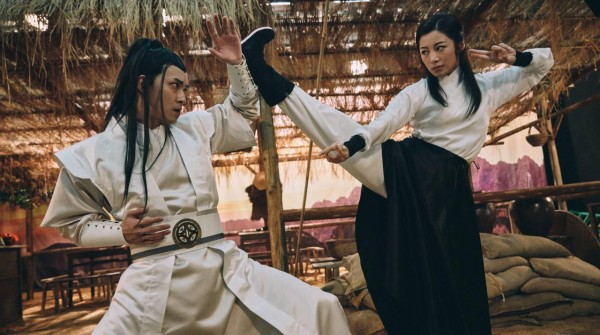
A SCENE FROM "BATTLE OF THE SEVEN STAR SWORDS" IN LEGENDARY IN ACTION!
A film about movie nostalgia and the rough and ready nature of the Hong Kong film industry
Legendary in Action! was directed by acting star Cheung Kin Sing, here making his first feature film and playing the director in the movie, Cheung Chi-piu. (The actor reportedly put on weight to convey the sense that his character, frequently seen puffing on a cigarette and looking depressed and disheveled, is going to seed.)
Legendary in Action! oscillates between movie dreams and movie realities, the latter exemplified by scenes showing the rough-shod Hong Kong moviemaking process. We see the director as a child watching old fashioned black and white wuxia films on a little TV, ecstatic. That is the dream, or the birth of it. Now, he is washed up even though still young. He was internationally praised at the Busan Festival, but that's forgotten, and one of the main topics here is money and the lack of it - and most of his funding vanishes when big producers run off and a more intimate one, his friend and producer Chuen (Lee Sang-jung) blows his wad gambling.
Cheung Chi-piu tries to rejuvenate his film by recruiting an aging kung fu movie star, Lung Tin, and a real one, Chen Kuan Tai, plays this role. It was he who played the lead in a series called The Seven Star Sword, which Cheung Chi-piu was particularly inspired by as a boy. Here, nostalgia and reality coincide, and the "meta" quality of this film achieves its best moments.
Legendary in Action! is a movie about making a movie (he Battle of the Seven Star Swords). The main action is the ruckus about organizing and funding and the messy shoots, which rarely seem to go right. It often feels as though the film itself is a mess: the action and continuity aren't altogether under control and the tone is inconsistent. But When Lung Tin, i.e. Chen Kuan Tai, is in action, though his over-energetic moves terrorize other cast members and override the confines of the script, his skill, even at his age, is impressive and fun to watch. Chen Kuan Tai really conveys a sense that in the heyday of old-style kung fu movies, as he keeps saying, cast, crew, and production values were all top-notch, and we believe him when he is scornful about the quality of present-day stunt performers and props and the lack of rigor and dedication in the filmmaking process.
But making a movie about making a movie is tricky, and it's not enough that director Justin Cheung (Cheung Kin Sing) is an experienced actor who knows the cinematic process from the inside: sometimes comedy and realism are at war with each other. Characters abruptly shift. A young woman recruited from a restaurant to be Lung Tin's costar starts out being mercenary and cruelly indifferent, then without explanation becomes his sweet, dedicated helpmate. It's suggested that Lung Tin is developing Alzheimer's, but that doesn't quite compute. Cheung Chi-piu's pregnant wife (Yang Sze Min) gets fed up with his lack of attention (cinema is his passion, still, sort of) and goes back to her mother; later she is back, affectionate and happy. Dialogue needed, if possible, to make these transitions smoother and more plausible.
These are factors that make one less than impressed with Legendary in Action!. But the performance of Chen Kuan Tai leaves an impression and arouses an urge to learn more about how wuxia and Hong KOng action filmmaking have diverged today. The director deserves credit just for taking us to the roughshod Hong Kong low bugdet filmmaking process. We know Wong Kar-wai made his films very rapidly, and perhaps chaotically. Only they turned out to be masterpieces and this didn't.
(For details I am indebted to a DeepL-translated version of an article about this film by Ryan in Chinese on hkfilmblog.)
Legendary in Action!/ 大俠Action! (in Cantonese), 92 mins., was screened for this review as part of the Jul. 15-31, 2022 New York Asian Film Festival. North American Premiere.
Sunday Jul 17, 3:30pm (Walter Reade Theater, Film at Lincoln Center)
Last edited by Chris Knipp; 07-11-2022 at 12:55 PM.
-
BIG NIGHT! (Jun Robles Lana, Philippines, 2021)
JUN ROBLES LANA: BIG NIGHT! (PHILIPPINES 2021)
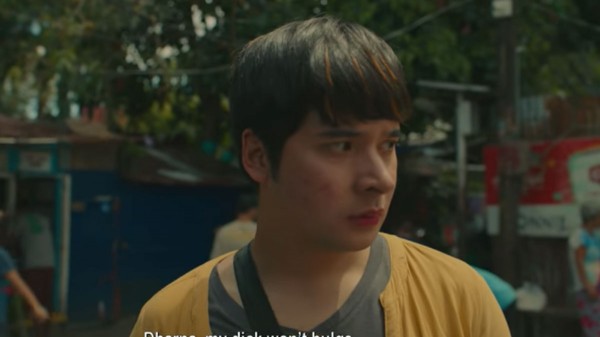
CHRISTIAN BABLES IN BIG NIGHT
TRAILER
A young Filipino spends all day struggling to get off a government hit list
Our previous experience of the films of Jun Robles Lana, who evidently is extremely well known in the Philippines, was the 2012 New York Film Festival selection, Bwakaw, for 2012 (a pretty great year for the NYFF), also with a gay main character and also involving locally famous actors. Though maybe local viewers or commenters make Big Night! more overtly political than it is, the terrorism of the dictatorial Duterte regime is the power that hovers over the protagonist, Dharna (the appealing Christian Bables), a young gay hairdresser, and determines all the action. Unlike Bwakaw's elderly gay lead character Dharna is openly gay, and has a boyfriend, Thor (Nico Antonio). The "Big NIght" is an event Thor is competing in that night, and that action is a big part of the celebratory structure that holds poor Filipino life together and one of the sub-climaxes of this busy, funny, disturbing film.
Things open with a casual street assassination, whose calm acceptance by bystanders shows how commonplace it is. Dharna gets an advance look at a new drug "Watch List" that has his name on it. That is, the old name he rejects, Panfilo Macaspac, Jr.; Dharna is his queer identity name that he embraces. He spends the rest of the action frantically seeking through favors and pleading to get it taken off, because being called in for "questioning" as an "addict" is an event that routinely leads to extrajudicial assassination. In the Philippines' surreal, Kafkaesque "war on drugs," it's the addicts who get punished, by the way, not the drug dealers. Dharna is neither; he's just caught up in the web.
The sequence of encounters with people possibly able to help Dharna get taken off the "watch list" leads to some funny, raunchy stuff. There's a little of everything, including a clash with Dharna's father (who accepts that he's gay) and with the spirit of his dead mother, smoking and now foul-mouthed, who turns out to be in hell, appropriately enough, since however ludicrous this action is, it's constantly hellish or at least purgatorial.
Some local authorities come in odd places, like a midwife, and to talk to her Dharna has to assist at a tandem birth event, two pregnant women lying side by side, one giving birth and one about to, both screaming. One viewer has suggested that Dharna's apparent difficulty looking at a vagina is either misogynistic or homophobic or both, but it's not certain anything is to be taken too seriously. There are plenty of dick jokes too. The film is full of grim jests and casual cruelty, especially the latter since the hero is constantly being put off or jerked around by petty authorities whom he is obliged to play up to.
There's an assurance in the completeness of scenes Dharna enters into, busy, messy, colorful collections of often ordinary characters who nonetheless harbor among them somebody who might have life and death power over someone as weak as Dharna, who's simply in no position to be dignified or brave. This is a world of petty power being ruthlessly exercised all the time.
After various petty officials who enjoy pretending to be important there's a former star from Filipino cowboy movies, Donato Rapido (John Arcilla). who comically shows off some of his old tricks. The favor he extracts is some dramatic acting by Dharna and his boyfriend in an ambulance, and it's obvious what's going on, and that in order to clear his name, Dharna has to sully it far more profoundly.
Big Night! has some longeurs: its semi real-time progression of trials has made that hard for director Lana to avoid. The film succeeds n in the details of its moment-to-moment texture more than in its overall structure, but it still manages a rather jaw-dropping finale. Local viewers, hoping for a thread of hope, are displeased with the cynicism of this ending. But despite the way Lana sugars the pill with lightness and camp, this is basically hell. And people see the truth of it.
Big NIght!, 105 mins., premiered at Tallinn Black Nights Nov. 25, 2021 and opened in theaters in the Philippines Dec. 25 2021. Screened for this review as part of the July 15-31, 2022 New York Asian Film Film Festival. New York premiere.
Wednesday Jul 27, 6:15pm
Film at Lincoln Center
Director Jun Robles Lana and Actor Christian Bables will attend the screening.
Last edited by Chris Knipp; 07-11-2022 at 12:58 PM.
-
revivals: HAPPY TOGETHER 春光乍洩 (Wong Kar-wai 1997)
NYAFF revival showing in the NYAFF July 16, 2022. Review originally published in Dec. 2020.
WONG KAR-WAI: HAPPY TOGETHER 春光乍洩 (1997)
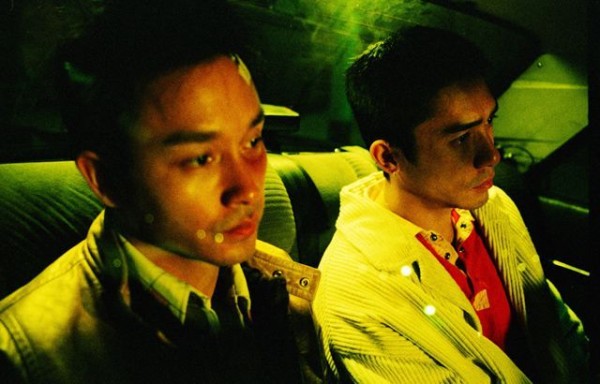
LESLIE CHEUNG AND TONY LEUNG IN HAPPY TOGETHER
Last tango in Buenos Aires - a new direction and new recognition
The earlier Wong Kar-wai films focused on romantic desire, longing, or frustration, loneliness or fleeting relationships. Happy Together shifts to a couple who've been together a while and are having problems, but can't seem to split up for long. For this turbulent gay love story Wong boldly used Leslie Cheung and Tony Chiu-wai Leung, two of the biggest Hong Kong male stars (Leung definitely straight), showing them passionately making out on a little bed in the very first scene. And Wong reportedly shot that first scene first, rubbing the actors' noses in the unaccustomed gay subject matter (unaccustomed at least for Leung). Maybe to get that out of the way, as some have suggested; but it's not the last gay sex glimpsed on screen. In this film, though, the physical side isn't so much the point. It's the emotional involvement of Po-wing (Cheung) and Yiu-fai (Leung) that counts. It's over but it's not over. It may have turned into nothing but care-taking and fighting, but the hold is as strong as ever.
The painfully back-and-forth of the relationship between sensuous, promiscuous Po-wing (Cheung) and responsible Yiu-fai (Leung) is underlined by the way Christopher Doyle's images shift back and forth between black and white and color. The scene-shifts are jerky; they jerk us around.
Wong Kar-wai temporarily avoided the issue of the 1997 Handover of Hong Kong to Chinese rule by shooting his 1997 feature abroad, in Buenos Aires, a location the director comfortably makes his own, even if his characters are aliens in it. The relentless, melancholy tango music of Astor Piazolla resounds throughout (and indeed, we get to see the principals tango together) - as does, later on, a Hong Kong rendition of the Turtles' song "Happy Together." Wong knew homosexuality would not fare well under the new regime so he took this last chance to make a film about that theme, treating gay love as a relentless "can't live with you, can't live without you" relationship that makes that title ironic.
Another irony is that Wong tones down his relationship with the brilliant, bold dp Christopher Doyle with a film of more straightforward (if still often gorgeous) images, and drops the fanciful double plot structures of his last two films in favor of the simple, linear one of the life abroad of three men (and no women). Yet somehow it's perhaps even harder for the viewer to get a foothold in this world that's so concretely depicted, in these scenes that are so simple, even as they evoke every turbulent relationship you may have ever had.
Yet the world is a concrete one of little shabby rooms. Wong's films have reveled in such rooms from the start, but never more tiny and shabby than the one Yiu-fai occupies after he and Po-wing break up - where Po-wing joins him after one brawl too many when he's helpless, with bandaged hands, jammed with a ghetto style crowd in the hallway below where people cook and there is the only phone. The lived-in quality of this setting reflects the extended time spent filming in Argentina, which was supposed to be brief but extended to four months.
Vivid also is the tiny tango bar where Yiu-fai works as a doorman in evening clothes, munching sandwiches or quaffing from flasks of liquor as he stands outside in the cold. It's here that Po-wing reappears by chance, arriving in cars with new male conquests or clients. As before, Leslie Cheung effortlessly exudes sensuousness and profligacy. Tony Leung is the orderly, hard-working one, but also a man who drinks and has a temper. We don't see what he does to end his employment at the bar, but it's violent.
One thing that threads the repetitious, believably going-nowhere narrative together is the couple's project, failed at the start, never abandoned, to visit a famous location, the Iguazu Falls, depicted on a cheap revolving lamp they had in the first tiny Argentine room, which Yiu-fai keeps. It's the objective correlative of the longing for a happy moment that can never be. But the real thread is the little room with the bed on one side and sofa on the other. When Yiu-fai is caring for Po-wing with the bandaged hands, they fight over who'll sleep on which. The secret is Yiu-fai never wants Po-wing to leave. All this is mostly from Yiu-fai's point of view. He thinks this is their happiest time. He hides Po-wing's passport.
After the tango bar Yiu-fai works in a kitchen. He becomes the only friend of a young twentyish Taiwanese guy, Chang (Chen Chang, who starred in Edward Yang's autobiographical A Brighter Summer Day at fifteen). They drink together and the intuitive kid hears in his voice the sadness Yiu-fai denies. They seem happy playing ball with other Chinese kitchen staff outside the restaurant and it's Decenber, therefore summertime, which Yiu-fai says passes quickly. But not quickly enough: he takes another night job at a slaughterhouse to save money and avoid the now lonely room, for Po-wing has escaped. Apparently Yiu-fai and Po-wing are not going to meet again. Yiu-fai goes to see Iguazu and views the falls alone. Chang has left to visit an extreme southernmost point where he's promised to leave Yiu-fai's sadness. Po-wing enters the old room, empty of his lover now, and weeps. Lots of touching little details here. The friendship of Chang and Yiu-fai is heartbreaking.
This first Wong film about an established relationship is the loneliest and saddest but the most touching so far. This film brought Wong the greatest international recognition he'd yet had. Yet some Anglo critics dismissed it as too plotless. It arouses mixed reactions in me. It's not as fun as the earlier films, or as glorious visually - despite Doyle's ability to make the most ordinary locations evocative and fresh.
On the other hand, this is more about grown-up experience than what has come before. But I feel dissatisfied, as is Mike D'Angelo, who has said Happy Together has all the elements he loves in Wong, the moody characters, lovely images, free structure, but irritates him by substituting the romantic yearning with endless squabbling. It's not quite that simple but that's kind of true nonetheless. As a gay person I have to be grateful for this movie from my cinematic idol, but I find Leslie Cheung more interesting in Days of Being Wild, where he's central, than Tony Leung, who's the lonely, reliable guy who dominates here.
Happy Together 春光乍洩 (Chun gwong cha sit, "Bright spring," the Chinese title reportedly an allusion - ironic? - to the Handover), 98mins., debuted at Cannes in Competition May 1997, winning Wong the directing prize. Viewed on a screener of the 4K restoration "undertaken from the original 35mm camera negative by the Criterion Collection, in collaboration with Jet Tone Films, with l'Immagine Ritrovata and One Cool," approved by Wong Kar-wai. To be shown in a series of six 4K restorations of Wong Kar-wai films in virtual theater from Dec. 11 2020 by Roxie Theater and BAM/PFA. In the NYAFF July 2022 it is included in the HKETO, Classic Marathon.
July 16, 2022 NYAFF showing:
Saturday Jul 16, 2022, 9:00pm (Hearst Plaza)
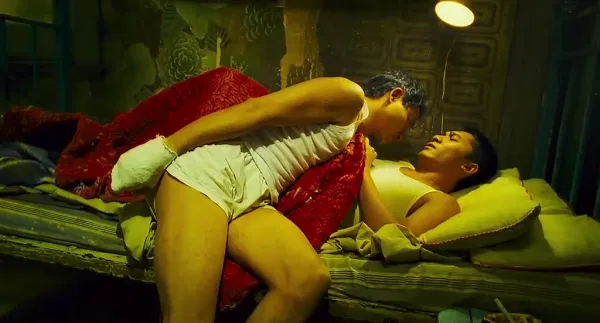
LESLIE CHEUNG AND TONY LEUNG IN HAPPY TOGETHER
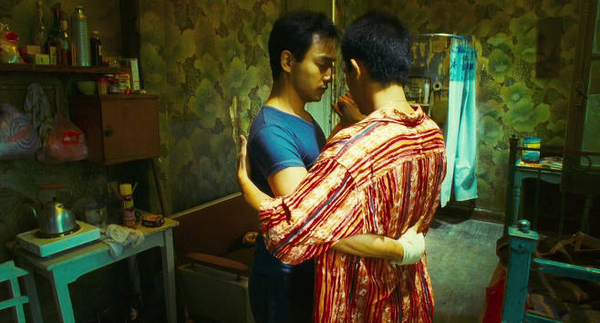
LESLIE CHEUNG AND TONY LEUNG IN HAPPY TOGETHER
Last edited by Chris Knipp; 07-12-2022 at 07:36 PM.
-
#LOOKATME (Ken Kwek 2022)
KEN KWEK: #LOOKATME (2022)

SHU YI CHING AND THOMAS PANG/AKA/YAO IN #LOOKATME
A lurid look at free speech, social media, and homophobia in Singapore.
The Singapore film #LookAtMe starts as jokey and turns shocking. It is urgent, violent, disturbing, lurid, and so campy it may wind up squandering many of its possibilities as social commentary, though it never ceases to be entertaining, or at least gripping.
The main action begins when Sean Marzuki (Thomas Pang/Yao), an ambitious but unsuccessful young Singapore YouTuber, goes viral for attacking and mocking a homophobic preacher. Sean has a gay identical twin called Ricky (both are played by Thomas Pang/aka yao, who's now finishing a masters at Yale Drama School).
It happens like this: Sean's girlfriend Mia (Shu Yi Ching) persuades the twins to attend a service of her parents' televangelist Baptist megachurch with her parents to show his, Sean's, bona fides. The service, after the pop music segment, morphs into a virulent homophobic sermon by Pastor Josiah Long (Adrian Pang), which we see in full. It is shocking, glib and hate-filled and seems all too real. (Later, in retrospect it doesn't seem real, but that's the way this movie works.) Something this retro-hateful would be likely not so fully spelled out in an American movie. This is all in English, by the way. The twins, horrified, stomp out of the megachurch, Sean's girlfriend with them. She acknowledges she made a big mistake, but in the event, her loyalty fades, since her parents are angered, not mollified.
Things have been stirred up, but it gets worse. Sean posts a powerful YouTube squib against the pastor, editing the TV footage of his sermon to make it look like he's hyping bestiality. This leads to multiple complaints to the police by members of the megachurch, and Sean is held on $30,000 bail. At last he's a YouTube hit - only he's now barred from future postings and must take down the provocative video.
It gets still worse - much worse. Sean winds up doing prison time in a large empty cell with some hardcore prisoners - an experience vividly, if rather stagily, depicted and worthy of a Samuel Fuller film. It's at this point that it becomes clear, if it wasn't before, that this movie is not realistic. The prison section seems something of a lost opportunity. It's here that movie had a chance of becoming more complex here, less blindly theme-driven. But the director is a little better at provocation and attention-grabbing than focused storytelling. His love of shock leads to simplistic effects. The film becomes so campy in exploring the horrors of prison life we may forget it's about real issues.
While Sean is in prison, Ricky becomes much more angry. He decides to use the old fashioned methods of public appearances, street demonstrations, and TV interviews to protest Singapore's anti-gay law, to make of his and the family's experience a cause. The failed gay lawyer who comes to defend Sean says fighting the megachurch "is not a case but a cause."
Eventually when he is released and learns how the megachurch's multiple suits have broken his now out of work and penniless mother (Pam Oei) and, worse, if possible, the grievous bodily harm that has been done to his brother Ricky by violent homophobes, Sean adopts a dictum of one of his cellmates and turns to violence and revenge. What seemed to start out being at least partly about earnestness and issues has lost its way in surreal fantasies. But then the film cleverly sidetracks Sean's attempt at becoming a revenge ninja. In the dramatic final minutes, Sean may be about to secure a role as an internet crusader. Only he'd better get the hell out of Singapore.
#LookAtMe is repellant more than once, boldly so. We're tempted to condemn it, but it's sure of itself in an all-over-the-place sort of way that makes one think maybe after all Ken Kwek has something and must have some cinematic chops, after all. There are serious flaws here. Plausibility goes out the window early. But he knows how to grab you.
Kwek's two previous features are Sex.Violence.FamilyValues. (2013) and Unlucky Plaza (2014).
#LookAtMe, 108 mins., in English, Mandarin, and Malay with English subtitles, has its world premiere at the July 15-31, 2022 New York Asian Film Festival, where it is in the Uncaged Award for Best Feature Film Competition.
NYAFF SHOWING: Sat. Jul. 23, 2022, 4pm, Walter Read Theater. World Premiere | Q&A with Ken Kwek, Yao, Pam Oei.
Last edited by Chris Knipp; 07-12-2022 at 07:32 PM.
-
THE GIRL ON A BULLDOZER 불도저에 탄 소녀 (Park Ri-woong, South Korea, 2022
PARK RI-WOONG: THE GIRL ON A BULLDOZER 불도저에 탄 소녀 (SOUTH KOREA, 2022)
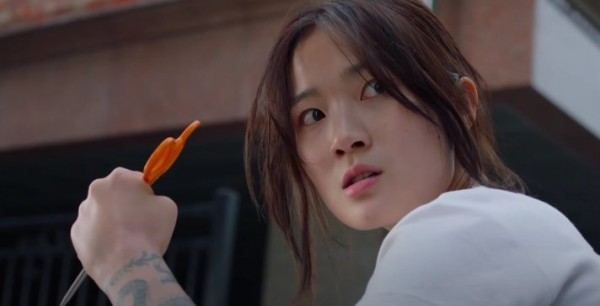
KIM HYE-YOON IN THE GIRL ON THE BULLDOZER
Korean super-girl
The feisty teenage girl in this movie is nearly indestructible. She has a mean look and a badass armful of tattoos. She also has little impulse control, but that can also be how you deal with problems fearlessly as they arise. And while her choice of violence seems wrong, she makes the wrongdoers against her no-count dad pay for their self-indulgence. In the end, she has served a term of forced education/community service and then after far worse misdeeds an eighteen-month jail sentence, and she comes out of it all apparently living a good life with her little brother. Perhaps her wild energy in future will be channeled into artistic endeavors. Whether all this makes any sense isn't altogether clear. But The Girl on a Bulldozer comes that close to being a very original movie and the actress an emerging star.
The teenage hothead is Goo Hye-young (Kim Hye-yoon). The film opens in a courtroom where the (lady) judge notes that in a restaurant brawl she protected three people, but she also began by striking them, and for that she gets a required course of public instruction in a trade. This is how she learns to drive a bulldozer, an odd choice since she's the first female ever to enter, but later she demonstrates that she (and actress Kim Hye-yoon) has learned to operate it effectively.
Hye-young's hard-nosed manner makes sense as a survival strategy. Her mother has been dead for years and her father (Hyuk-kwon Park) is unreliable and incompetent and can't pay the bills, which include multiple insurance premiums. At present he is in hospital following an accident. It turns out he hit several people, had been drinking, and was driving a vehicle stolen from his former boss. His condition worsens and he is declared brain-dead. This leaves Hye-young to care for her little brother. But that was true already.
The situation is too complicated to go into here. The former boss has turned over property to dad where he has set up a small restaurant. It turns out this man, who is a candidate for local government office glad-handing everyone now, is a slimy individual who has exploited Hye-young's father and misled him. Hye-young's dad had gone to confront him about this, leading to the stolen vehicle. The accident claims of the two dad hit turn out to be fraudulent. Dad isn't at fault, and the two "victims" may even be scammers. Hye-young sets out to expose him and in the course of her investigations, which happen all in the course of a single, impressive, madly determined day, she finds proof. When the boss sends money to pay her off, she takes it, dumps it on the floor of his posh flat, and attempts to douse it with gasoline and set fire to it. There's incorruptibility for you. That measure fails, so she commandeers the training bulldozer and goes on a rampage and does some serious damage, not only to the property the boss is planning to steal back, but to the posh flat.
After Hye-youn is out of jail and working at a restaurant, she gets wonderful news from the series of insurance companies. Several years later they have reversed their judgment and validated her dad's policies and each one is making a payment to her as the next of kin.
Clearly the filmmakers are out to show us the intricacies of petty local corruption most of all and thumb their noses at them with Hye-young as a kind of objective correlative of their righteous indignation, though they ignore the rule that two wrongs don't make a right. But when we think about it, righteous heroes or heroines - Supermen - do a lot of property damage. There is a part of us that relishes such displays.
Kim Hye-yoon gives a rousing and convincing performance as Hye-young. Look for her in future high profile films.
The Girl on the Bulldozer 불도저에 탄 소녀, 112 mins., opened in Korea 7 April 2022. Screened for this review as part of the July 15-31, 2022 New York Asian Film Festival, where Kim Hye-yoon receives the Screen International Rising Star Asia Award. New York Premiere
NYAFF SHOWING: July 25, 2022, 8:30 pm at the Walter Reade Theater, Lincoln Center.
The only English language review is an enthusiastic one on the Korean blog site Society Reviews.
Last edited by Chris Knipp; 07-25-2022 at 08:05 PM.
-
I AM MORE 모어 (Lee Il-ha, South Korea, 2021)
LEE IL-HA: I AM MORE 모어 (South Korea, 2021)
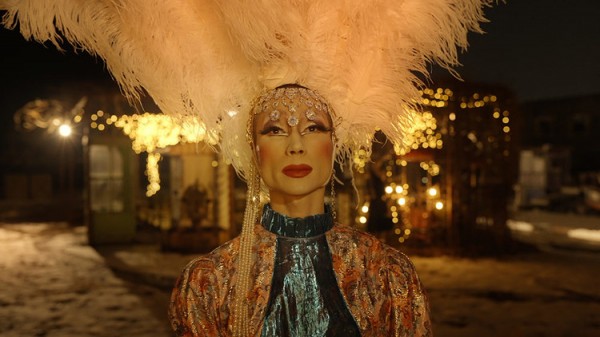
INTERVIEW
Documentary portrait of an elegant Korean trans dancer and drag queen
A New York ASian Film Festival blurb for this film describes it as "A compassionate, colorful documentary about Korean transgender trailblazer and fabulous drag queen 'MOre,' whose years of rigorous training as a ballerina culminate in an invitation to dance in New York." You can call MOre a "transgender trailblazer," but I'd say Mo-Jimin is the classiest drag queen you've ever seen. Mo-Jimin gets cast in a show in New York in June 2019, 13 Fruitcakes at Theater La MaMa, to commemorate the the fiftieth anniversary of the Stonewall riots, and this important event in the life of the well-known Korean drag performer is the pretext for this documentary.
Should one refer to MOre (or is it simply "More"?) as "he" or "she" or something else? In an online interview with MOre in Korean, MOre says he is "Not a woman or a man, but a person who lives in pursuit of beauty." His boyfriend calls him "him," so we'll do that, but we may slip into "she" and that's natural, MOre is gender-fluid. David Cameron Mitchell, Wikipedia tells us, in 2022 "came out as non-binary, but still chooses to be addressed by he/him pronouns."
We don't wind up seeing much of the New York 13 Fruitcakes show; the main focus is on MOre. We see dozens of clips of MOre in heavy makeup, with the longest fake eyelashes you've ever seen, nearly as long as Salvador Dali's mustaches sometimes, wearing fantastic costumes, twirling and posing in beautiful settings, including dancing quite convincingly on her toes in preparation for the Fruitcakes show, in a brand new pair of ballet pointe shoes. (Her gymnastic skill shows in her incredible balance.)
We learn MOre may have been barred from full ballet studies in Korea. However, some details remain a bit vague in I Am MOre. The film mainly blends clips of MOre's drag performances (or posing in magnificent drag, or naked, in outdoor settings) with footage of him in the present moment. We don't learn much about 13 Fruitcakes or the Korean company involved in it. Its website shows it is a celebration through vignettes of thirteen significant LGBTQ figures, including several Korean ones and Virginia Woolf, author of the gender-shifting novel Orlando. MOre says he is going to play Orlando. But he played multiple roles, and must have beenthe main or one of the main performers, though the film doesn't make that clear.
We regularly encounter MOre's big bearish longtime (Russian? 20-year?) boyfriend Zhenya, a Pokemon devotee, who plans to perfect his Korean while on an 18-month job-seeking visa and apply for citizenship but is currently out of work. In an earlier clip he doesn't look so big and bearish; they look more alike and more like a regular affectionate gay couple in speedos at the beach. MOre, petite, wafer-thin and disciplined, is a convincing ballerina, a small, light classical dancer. By the way, classical ballerinas tend to have flat chests, though MOre seems to pad his when in ballet garb sometimes.
We meet MOre's friendly parents and her sister. Growing up in the country, she may have experienced less bullying than - but not none. He went to study ballet at the Korean National University in Seoul, where right away, he says, a male ballet student knocked him down and said "get rid of the femininity." Homophobia was and is strong in Korea, and to illustrate that, "eradicate Queer" festival and several other overtly homophobic street events are glimpsed.
MOre meets up with a famous American gay icon, John Cameron Mitchell of the 1998 trans musical classic Hedwig and the Angry Inch, whom he had met in Korea years earlier. He recounts trying suicide in school before a test but throwing up the 50 pills and going in and taking the test. Later, in the army, she came out and as a result was classified as insane and sent to a mental hospital. At that time (many clips are shown) MOre discovered Itaewon, Seoul's "party" and gay and drag district, and began dancing like crazy, and crazily, dancing all night, sometimes till he foamed at the mouth. She found joy, an escape from a life she saw as miserable. These moments are helter-skelter in the film's somewhat jerky progression that is held together by MOre and his serene, elegant, disciplined face.
Unfortunately when MOre sees Mitchell at his apartment in Manhattan it turns out he can't see 13 Fruitcakes; he has to be away that weekend to receive an award and perform in Provincetown. A sad letdown, but they hug and exchange gifts.
Though he says his being born with balls was a big mistake and he knew this from the beginning of his life, in a a revealing conversation with a prizewinning Korean transgender beauty MOre reveals he has given up the idea of surgery because it was always "too scary" and he has no regrets about that anymore, for one important reason because he knows that he has Zhenya's fully accepting love as he is. The film ends with a focus on the couple celebrating with sparklers at night, laughing and happy. The image that remains from this film is of MOre in a magnificent black costume posing in front of a grand building in the snow, but there is no still of this scene available, alas.
I Am More 모어 ("Mo-eo"), 121 mins., debuted Sept. 11, 2021 at DMZ Doc Fest, showing also at Busan Oct. 9, 2021. Screened for this review as part of the Jul. 15-31, 2022 New York Asian Film Festival. North American Premiere
NYAFF SHOWTIMES: Sun., Jul. 24, 2022, 7pm at the Walter Reade Theater.
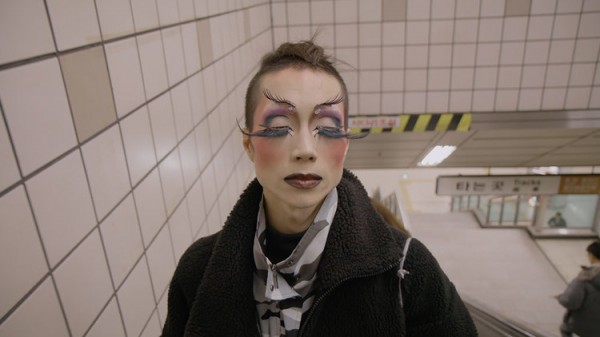
Last edited by Chris Knipp; 07-25-2022 at 07:49 PM.
 Posting Permissions
Posting Permissions
- You may not post new threads
- You may not post replies
- You may not post attachments
- You may not edit your posts
-
Forum Rules





 Reply With Quote
Reply With Quote












Bookmarks